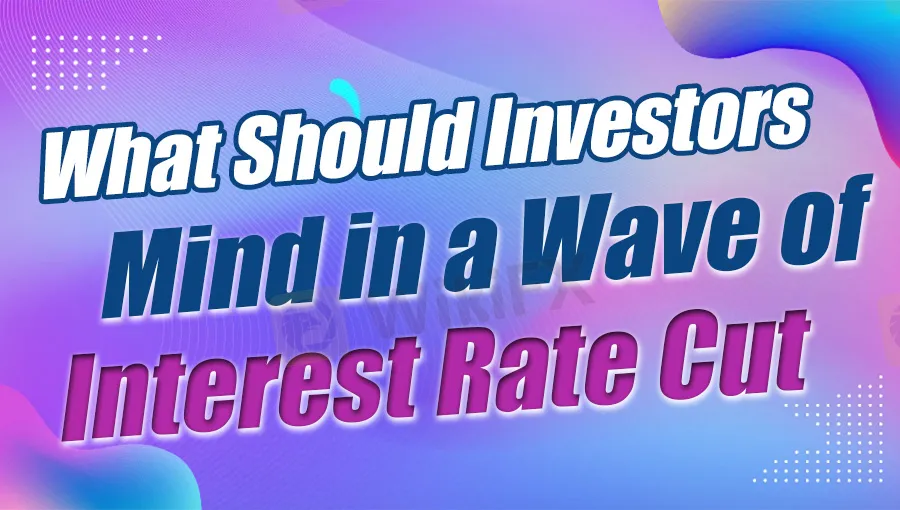简体中文
繁體中文
English
Pусский
日本語
ภาษาไทย
Tiếng Việt
Bahasa Indonesia
Español
हिन्दी
Filippiiniläinen
Français
Deutsch
Português
Türkçe
한국어
العربية
What Should Investors Mind in a Wave of Interest Rate Cut
Abstract:Central banks around the world are stepping up their quantitative easing efforts to stimulate an economic recovery. On September 12th, European Central Bank (ECB) announced after decision meeting to further cut the deposit reserve rate from -0.4% to -0.5%, while restarting the quantitative easing scheme from November with a plan to purchase €20 billion-worth of bonds each month. On September 19th, US Federal Reserve will also release its decision on interest rate, which is expected to be down by 25 basis points in September.

US and European Union start a new wave of interest rate cut
Central banks around the world are stepping up their quantitative easing efforts to stimulate an economic recovery. On September 12th, European Central Bank (ECB) announced after decision meeting to further cut the deposit reserve rate from -0.4% to -0.5%, while restarting the quantitative easing scheme from November with a plan to purchase €20 billion-worth of bonds each month. On September 19th, US Federal Reserve will also release its decision on interest rate, which is expected to be down by 25 basis points in September.

Emerging economies in Asia may be next
Since the beginning of this year, the manufacturing in Asian countries and regions have experienced low tides due to trade war and other financial incidents. With the Purchasing Managers' Index (PMI) dropping below the 50 mark, many emerging market economies in Asia are joining the US and EU in cutting interest rates. This week has seen slight fluctuations in Asian currencies, with dips in the prices of PHP, INR and MYR against USD. Over 10 Asian economies including the Philippines, India, Malaysia, Thailand and Indonesia may try to boost domestic economy through further interest rate cut. According to a survey of Reuters, Bank Negara Malaysia may keep its benchmark interest rate unchanged on Thursday to save room for further interest rate drop to counteract domestic economic slowdown and uncertainties in global trade.

Risks that forex investors should beware of
Advanced economies like European countries may benefit from currency depreciation as it creates economic stimulus through inflation and more competitive exportation. However, devaluation of currency may lead to excessive deflation which will further harm the already vulnerable economy in developing countries. The latest wave of interest rate drop has driven prices of currencies to their lowest point in many years, which not only causes investors heavy losses but also shakes the global market.
Forex market is full of uncertainties, which require investors be more risk-conscious and follow the latest market trends, particularly the macroeconomic policies, including fiscal and monetary policies, of central banks, as they have direct implications on forex rates. In addition, key economic indicators as well as investors‘ hedging sentiments will also affect the rate of currencies. If you’d like to learn more about forex market trends and investment tips, you can download the WikiFX App to check out the forex information we constantly update for investors.

Disclaimer:
The views in this article only represent the author's personal views, and do not constitute investment advice on this platform. This platform does not guarantee the accuracy, completeness and timeliness of the information in the article, and will not be liable for any loss caused by the use of or reliance on the information in the article.
Read more

Europe Analysis: EUR/USD, GBP/USD, EUR/GBP
EUR/USD is mixed to bearish, influenced by resistance levels and upcoming data. GBP/USD is bullish with the pound at four-month highs on positive UK data and hawkish BoE comments. EUR/GBP remains volatile, reflecting diverging economic conditions in the Eurozone and the UK.

Europe Analysis: EUR/USD, GBP/USD, EUR/GBP
European trading is subdued due to the U.S. holiday, with the euro benefiting from weak U.S. data. The pound rises ahead of the UK election, supported by market sentiment. ECB President Christine Lagarde's comments on interest rates support the euro. Overall, mixed sentiment prevails with cautious trading expected. Key economic events include Eurozone retail sales, Germany's industrial production, and UK services PMI.

Rate Rumble: RBNZ, BoC, and ECB Take Centre Stage
The New Zealand central bank maintain its benchmark interest rate at 5.50% as expected during its previous meeting. While there was no surprise of the central bank paused rates, the less hawkish tone was a surprise as 23% of the market surveyed by Reuters predicted an interest rate hike. In February, the rate of consumer price growth in the United States picked up pace with the reading came in at 3.2%, surpassing expectations of 3.1% for underlying inflation.

Markets Q4 Outlook: Dow Jones, US Dollar, Gold, Fed, Euro, ECB, Oil, Volatility Returns?
As investors head into the fourth quarter, the VIX Volatility Index - often referred to as the market‘s ’fear gauge - is in an uptrend. In September, US benchmark stock indices saw some of the worst monthly performance since March 2020. In fact, the S&P 500 and Nasdaq 100 finished the third quarter little changed. More importantly, they trimmed most of their gains. The Dow Jones declined.
WikiFX Broker
Latest News
Two Californians Indicted for $22 Million Crypto and NFT Fraud
Macro Markets: Is It Worth Your Investment?
WikiFX Review: Is Ultima Markets Legit?
Colorado Duo Accused of $8M Investment Fraud Scheme
What Impact Does Japan’s Positive Output Gap Have on the Yen?
RM62k Lost Investment Scam After Joining XRP Community Malaysia on Telegram
Victims of Financial Fraud in France Suffer Annual Losses of at Least €500 Million
Trading is an Endless Journey
SEC Warns on Advance Fee Loan Scams in the Philippines
Malaysia Pioneers Zakat Payments with Cryptocurrencies
Currency Calculator


